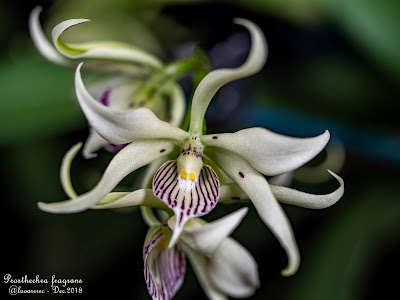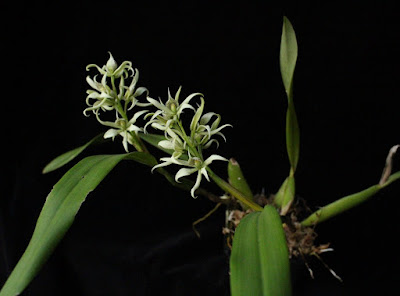Prosthechea fragrans - Fragrant Prosthechea flowers are fragrant, 3.75 cm in diameter, whitish, with purple radial stripes on the lip. Lip is joined..
Prosthechea fragrans, also called as Fragrant Prosthechea, Anacheilium fragrans, Encyclia fragrans, Epidendrum fragrans, Epidendrum fragrans var. pachypus, Epidendrum ionoleucum, Epidendrum lineatum, Epidendrum vaginatum, Prosthechea fragrans f. alba, is a species in the genus Prosthechea. This species was described by Wesley Ervin Higgins in 1998.
DESCRIPTION OF PROSTHECHEA FRAGRANS - FRAGRANT PROSTHECHEA
Prosthechea fragrans is native to Southern Mexico to Tropical America. It is found growing in the canopy of dense non-deciduous cloud forests in Bolivia, Brazil North, Colombia, Costa Rica, Cuba, Dominican Republic, Ecuador, French Guiana, Guatemala, Guyana, Haiti, Honduras, Jamaica, Mexico Southwest, Nicaragua, Panamá, Peru, Suriname, Trinidad-Tobago, Venezuela, Venezuelan Antilles, Windward Is. at elevations of 800-2000 meters above sea level.
It is a medium sized, warm to cool growing epiphyte with cylindric to fusiform, narrowly ovoid, very variable in size pseudobulbs and basal bracts that become papery with age. The single leaf is coriaceous, ligulate oblong to narrowly elliptic-lanceolate, obtuse, to 20 cm long.
Fragrant Prosthechea blooms in winter and spring from the apical, erect, to 10 cm long, 3 to 10 flowered, racemose inflorescence that arise on a newly matured pseudobulb. The flowers are fragrant, 3.75 cm in diameter, whitish, with purple radial stripes on the lip. Lip is joined to the base of the column; free portion is dilated on the simple lamina, apiculate; disc with a V-shaped callus at the base, with two small parallel calli; column is nailed, trilobed at the apex.
PROSTHECHEA FRAGRANS - FRAGRANT PROSTHECHEA CARE AND CULTURE
Cultural information should only be used as a guide, and should be to be adapted to suit you. Your physical location; where you grow your plants, how much time you have to devote to their care, and many other factors, will need to be taken into account. Only then can you decide on the cultural methods that best suit you and your plants.
Light:
Prosthechea fragrans needs a light level of 20000-30000 lux. The light should be filtered or diffused and the plants should not be exposed to direct midday sun. Strong air movement should be provided all the time.
Temperature:
In summer, the average day temperature is 24-27 °C, and the night 14-16 °C, with a daily amplitude of 8-10 °C. In winter the average daytime temperatures are 23-25 °C, and 13-15 °C during the night, while the daily amplitude is 8-11 °C.
Humidity:
Fragrant Prosthechea needs the humidity of 80% in the period of growth, in winter and spring it falls to 60-70%. Too dry air has a negative effect on the development of the plant: its growth is inhibited, and the leaves begin to turn yellow and dry out. The higher temperature, the higher the humidity should be, and the higher the humidity, the more often and longer it is necessary to ventilate the room where the plants are contained, otherwise the probability of rotting and various kinds of fungal diseases. Good air movement is essential while the plants are in leaf and growing.
Substrate, growing media and repotting:
Prosthechea fragrans grow well mounted on pieces of tree fern or cork, but in summer this requires high humidity and daily watering. In the period of extremely hot and dry weather, fixed plants may require even several watering times a day.
However, since most growers find it too difficult to maintain sufficient moisture with this growing method, these plants are usually grown in pots using an airy, fast-drying substrate that contains substances such as perlite to keep moisture out and charcoal to keep it airy and prevent acidification. Plants should be repotted at the end of winter or early spring, when new root growth begins.
Watering:
The plants should be watered abundantly during active growth, but their roots must dry out quickly after watering. At the end of autumn, the amount of water should be gradually reduced.
Fertilizer:
Fragrant Prosthechea should be fertilized every week 1/4-1/2 of the recommended dose of fertilizer for orchids. A fertilizer with a high nitrogen content is beneficial from spring to mid-summer, and a phosphorus-rich fertilizer can be used in late summer and autumn. Higher phosphorus content stimulates better flowering in the next season and promotes hardening of new growth before winter.
To avoid the accumulation of mineral deposits during periods of strong fertilization, it is recommended to rinse the containers approximately every month.
Rest period:
Prosthechea fragrans grown in cool conditions should be kept relatively dry in winter, with occasional fogging between rare waterings. However, those grown in warmer conditions need more water and significant drying up between waterings. However, it must not be allowed keep them dry for a long time. Fertilization should be reduced or eliminated until new growths appear and watering begins more abundantly in the spring.















COMMENTS